



While fermentation has been used for thousands of years to create foods like cheese, chocolate, yogurt, sourdough breads, beer and pickles, cooks around the world have now begun to discover or, more accurately, to rediscover the possibilities of using fermentation processes in the kitchen. Lacto-fermented vegetables, wild-culture breads, laphet (fermented tea leaves), tepache (a fermented Mexican pineapple-based beverage) and koji (Japan’s famous soybean and rice ferment) are allowing chefs and home cooks to create entirely new flavours from existing ingredients.
What is fermentation?
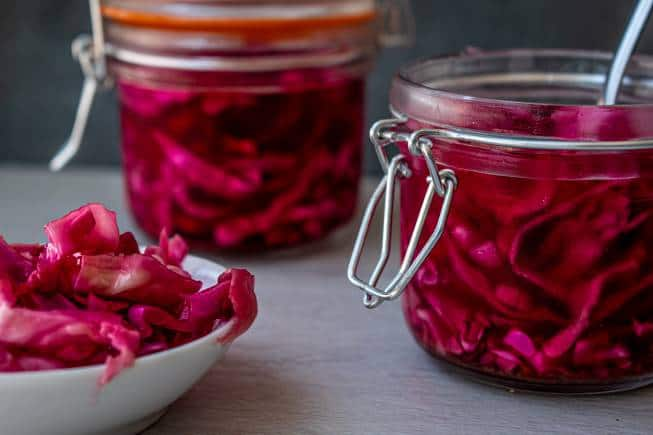 Pickled cabbage in clamp-lid jar. (Photo via Unsplash)
Pickled cabbage in clamp-lid jar. (Photo via Unsplash)
Fermented is a euphemism for rotten or spoiled. It refers to an anaerobic process involving the application of natural bacteria feeding on the starch and sugar present in the food to produce lactic acid. This helps preserve the food and extend shelf life.
Though fermentation is often classified as one of the oldest forms of food preservation, it’s more than that, says Moina Oberoi, wellness chef and founder of MO’s, a health food company that specialises in kefir, a yogurt-like drink. “When we ferment batters or dough the natural yeast from our environment pre-digests the grains, making it not only easier for our body to digest, but also making the nutrition more bioavailable to our system.” Our immune system, which encompasses our overall well-being, predominantly relies on our gut health. Fermented foods provide different types of good bacteria to our gut, and this bacteria acts as the fuel to our gut engine keeping our immunity strong and functional, she adds. It’s possible that COVID-19 has helped boost fermented foods to its top position since these products often contain probiotics which can aid in digestive health, immunity, and overall wellness. Topics that have been on everyone’s mind in recent years amid a global pandemic.
Though fungus and cultures may hardly sound appetising, fermentation experiments are bringing "funky flavours" to foods.
Today's fermentation innovators are changing the food we eat either by crafting entirely new fermented foods or adding fermentation to typically unfermented foods. Vanika Choudhary, founder and chef at Mumbai-based Noon has been using over 25 home-made ferments to add umami and texture to the dishes served at the restaurant. “I get my love for fermentation from what I absorbed and observed during my childhood. I would see my Nani make at least 30 different pickles in different seasons. Fermentation allows us to experiment with different flavour profiles using native ingredients and create something completely contemporary.”
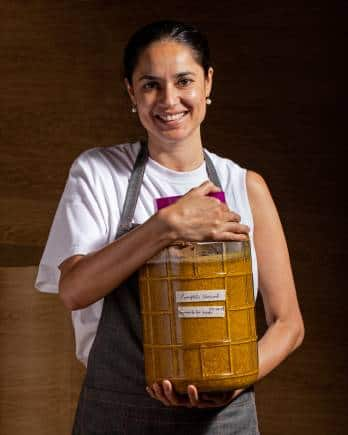 Vanika Choudhary, founder chef at Noon in Mumbai, with Pumpkin Kasundi.
Vanika Choudhary, founder chef at Noon in Mumbai, with Pumpkin Kasundi.
For Mihir Lavande, senior sous chef at Ekaa the biggest draw is the adaptability and ease of the process. “What I like most about fermentation is how adaptable and easy some things are to make. For basic lacto-fermentation, you only need vegetables and some salt. Other things like making koji, amino sauces and garums require much more patience, technical know-how and equipment, but the end result is worth it. At Ekaa, we use fermented carrots in salad, fermented plums to make sauces and kombucha is the basis for one of our tasting menu courses.”
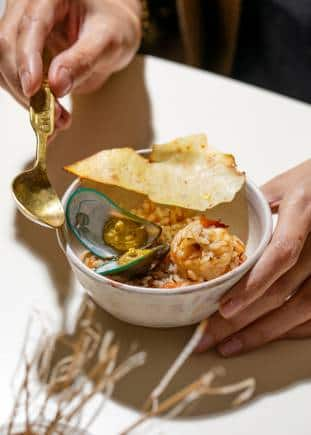 Yarkandi Pulao with mussels at Noon, Mumbai. The dish incorporates fermented ingredients.
Yarkandi Pulao with mussels at Noon, Mumbai. The dish incorporates fermented ingredients.
And it’s not just fancy restaurants with test kitchens dabbling with microbes. Home-fermentation too is having a moment. Amazon lists page upon page of cookbooks on the subject released in the last two years. Google Trends traces steady ascent for “fermented foods” and “probiotics” and “sauerkraut” over the last decade. Cutting-edge microbiologists have recently become preoccupied with fermented foods, using them to get a handle on the dazzling complexity of the microbiome. Everybody and his sister appears to be making (or, at least, drinking) kombucha. Fermentation also appeals to the millennials who are seeking out novel taste, texture experiences and international cuisines.
Koji takes the crown
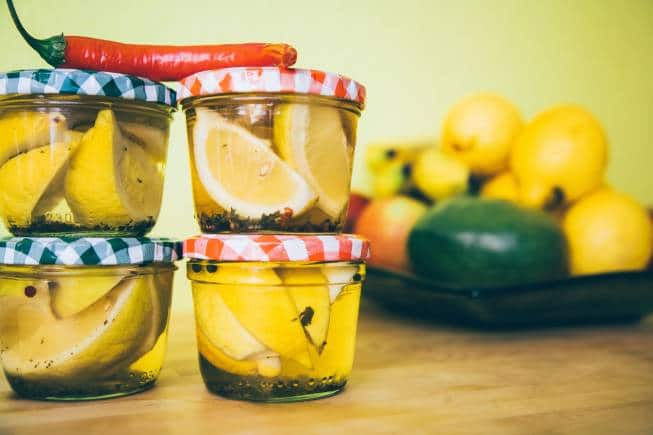 Home-made fermented lemon. (Photo via Unsplash)
Home-made fermented lemon. (Photo via Unsplash)
While the fascination for things like kimchi, kefir and kombucha has been gaining steam for some time, koji is the latest darling on the fermentation scene. This Japanese ingredient is currently a hit with chefs, to add a touch of umami and complex flavours to recipes. It's not eaten on its own, but grown on partially or fully cooked grains, such as rice and barley. As the spores begin to flourish, enzymes convert the grain into sugar, and then the enzyme-rich grain is added to a second product, such as soybeans. This secondary fermentation process causes a complete transformation in flavour and texture. It's how soybeans become miso, rice becomes sake, and how soybeans plus wheat become soy sauce. And the resulting flavour is something we all love — umami.
Choudhary has been making koji using ambemohar, a local rice variant in Maharashtra. Currently, the test kitchen at Noon is reimagining Indian cuisine with koji-based fermentation. A batch of kalari, the indigenous cheese, made by the Gujjar community in Pahalgam is being infused with the cultured brilliance of koji, a pickle of galgal also known as Himalayan lemons is getting a koji boost while Tamatar ka Achaar, an Odia delicacy is being aged for two months along using koji. At Ekaa, koji is used as a marinade for meats and koji oil as a seasoning and finishing ingredient.
Fermenting Cocktails
 Spicy Michelada, a cocktail at the Mexican grill restaurant Miss Margarita, Goa.
Spicy Michelada, a cocktail at the Mexican grill restaurant Miss Margarita, Goa.
Fermentation has always played a huge role in drinks; it’s the same process which turns grape juice into wine and creates the alcohol in beer. But, now, bartenders are bringing a host of other fermented ingredients to the party. From koji and kefir to homemade wine and vinegar, bartenders are increasingly experimenting with fermentation to create their own unique serves. “Fermented foods have a unique flavour that is tangy, pungent and aromatic. Using ingredients such as brines, pickles, house made vinegars, etc., are a great way to create interesting and complex flavour in drinks,” says Jishnu AJ, head mixologist, Ekaa. The restaurant makes its own version of the classic gin-based cocktail Gibson using homemade pickles like figs, carrots, and bell pepper and using the brine in the cocktail. Tender coconut wine (coconut toddy) is a major component of a cocktail called Petrichor, whereas morel mushroom wine sourced from Kashmir elevates bourbon drink named Old Foraged.
Fermentation can also help bartenders create drinks that their customers can’t find elsewhere. Noah Barnes, chef and co-founder of the Delhi-based Mexican restaurant Miss Margarita has been making is own hot sauce to be used in the popular Mexican cocktail michelada. “The sauce is made using chipotle chilies fermented for 30 days. The fermentation gives the spicy, tart drink a umami flavour and also adds a level of acidity. We rim the glass with tahini spice.” Sounds wildly delicious.
Bring it on: Magic of the microbes
Here’s how to to include fermented foods in your diet:
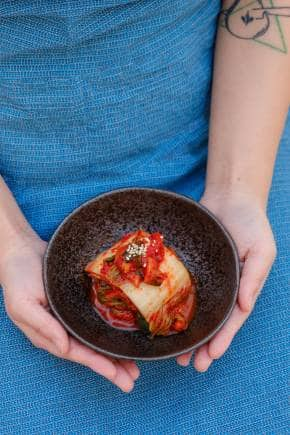 Kimchi is made by lacto-fermentation, the same process that creates sauerkraut and traditional pickles. (Photo via Unsplash)
Kimchi is made by lacto-fermentation, the same process that creates sauerkraut and traditional pickles. (Photo via Unsplash)
Discover the latest Business News, Sensex, and Nifty updates. Obtain Personal Finance insights, tax queries, and expert opinions on Moneycontrol or download the Moneycontrol App to stay updated!
Find the best of Al News in one place, specially curated for you every weekend.
Stay on top of the latest tech trends and biggest startup news.